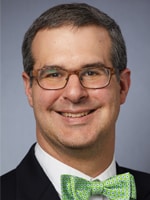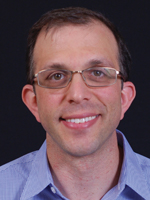Charna Albert
November 2022—In mid-October, flu was picking up, with high levels of activity in Texas, Georgia, the District of Columbia, South Carolina, Tennessee, and New York. Elsewhere, it was still on the lower side, with less known about what was to come but plans in place. And questions, too, about laboratory testing as it relates to SARS-CoV-2, “which is going to be a challenge,” says David Peaper, MD, PhD, D(ABMM), a member of the CAP Microbiology Committee.

Dr. Peaper
For example, how much testing do those who have respiratory virus symptoms but who test negative at home for SARS-CoV-2 need? Should schools require negative flu and respiratory syncytial virus test results in addition to a negative SARS-CoV-2 result in their COVID reentry protocols? What should workplaces require for an employee with respiratory virus symptoms but negative for SARS-CoV-2 with an at-home test? “There are questions around that that the laboratory may be asked to deal with, and a lot is going to depend on how different groups and institutions view the need to test for COVID and for other respiratory viruses,” says Dr. Peaper, associate professor of laboratory medicine, Yale School of Medicine, and director of the clinical microbiology laboratory, Yale New Haven Hospital.
Cases of rhinovirus had risen by mid-September. “The numbers aren’t huge compared to COVID or [a typical] flu season,” said Benjamin Pinsky, MD, PhD, “but certainly there’s a bump in the positivity rate.” The Centers for Disease Control and Prevention in September issued a health advisory about an increase in pediatric hospitalizations in patients with severe respiratory illness who also tested positive for rhinovirus and/or enterovirus, noted Dr. Pinsky, professor of pathology and of medicine (infectious diseases), Stanford University School of Medicine, and medical director of the clinical virology laboratory, Stanford Health Care and Stanford Children’s Health. Some are hypothesizing, Dr. Peaper says, that the lack of exposure to flu in recent years that could mean a more severe flu season could mean the same for rhinovirus in children—a more severe season. “If you take all of that together, which is a lot of unknowns, then you do have a theoretical possibility for a pretty bad flu season and a pretty bad respiratory virus season.” By mid-October, pediatric RSV case numbers had spiked in more than two dozen states. By Oct. 24, experts were predicting a rough season.

Dr. Pinsky
Information about the severity of disease in the Southern Hemisphere wasn’t yet available in early fall, but in a season with high numbers of influenza cases, which the Southern Hemisphere had, “you’re going to have more cases of severe flu,” Dr. Peaper says. “It’s at that point just a numbers game.” Another concern: “If we have a higher peak, or as we learned with COVID if the peak is very compressed, that’s going to put a lot of burden on the health care system and on laboratories to keep up with testing.” And for laboratories, “when we have a big peak or a severe season, then there’s a very long testing tail,” in which testing persists even after viral activity has declined. “It doesn’t necessarily turn on and off,” Dr. Peaper says. “Providers are still worried about flu, testing for flu. People still are concerned about it.”
Laboratories already have been testing many if not all admissions for SARS-CoV-2, Dr. Peaper says, “so adding on additional respiratory viruses may not be as complicated as it has been in the past.” But if schools and other institutions begin to require testing for the seasonal respiratory viruses, for example, that testing would fall to the laboratory.
One of Yale New Haven Hospital’s clinical ambulatory practice groups has implemented point-of-care PCR testing for SARS-CoV-2, flu, and RSV, as well as a point-of-care strep test. “So they are in a better position to do more testing and sensitive nucleic acid amplified testing in their offices,” Dr. Peaper says. Other groups may prefer not to see respiratory virus patients or patients with such symptoms in the office until they have tested negative for SARS-CoV-2. “So those groups may be sending us less testing.” But some areas or laboratories that still have organized specimen collection sites for SARS-CoV-2 may do the same for influenza and RSV. “So we could see some influx of testing in that way.”
“The past few years have been interesting,” he says. “I don’t see how this one will be any different.”
In spring 2020, Yale New Haven Hospital formed a cross-institutional COVID testing stewardship group that included university, hospital, and ambulatory group representatives. Its central purpose was to formulate a SARS-CoV-2 testing strategy, says Dr. Peaper, who co-chairs the group. “And now that has broadened to include the [seasonal] respiratory virus testing strategy, as well as the guidance and priorities within our testing populations about who should get what test and when.” They look at testing trends, positivity rates, supply chain, the testing that’s available across the system, and more, and they work closely with IT teams on the electronic health record order streams.
“Streamlined pathways were developed for COVID, and whether those pathways should be used for other respiratory viruses is what’s being discussed now,” he says.
For ambulatory patients there will be SARS-CoV-2 standalone testing, testing for SARS-CoV-2 and influenza A/B, or a fourplex test for SARS-CoV-2, influenza A/B, and RSV, “depending on the patient and how the provider interacts with them.”
The laboratory will perform its testing on the Roche Cobas 6800, Cepheid GeneXpert Infinity, and Hologic Panther Fusion. “We’re piecing that together,” Dr. Peaper says. “And we also have BioFire testing for specific populations.” For high-priority symptomatic patients who are admitted, “we’re trying to do what we can to get all of those turned around within a couple of hours, so those will go to the Cepheid GeneXpert.” Testing is performed 24/7 with staff from the microbiology and virology laboratories.
The seasonal respiratory virus assays the laboratory performs now were implemented during the pandemic, Dr. Peaper says. “We had been doing flu testing on the GeneXpert prior to the pandemic, but we’ve converted over to fourplex testing.” While some laboratory-developed tests are still performed, especially for lower respiratory specimens, the laboratory has converted mainly to commercial assays for its respiratory virus testing. “There are pros and cons, but there’s been tremendous demand on the laboratory workforce to maintain the skill set and expertise to develop LDTs at scale. And the commercial kits and instruments are designed to operate at a higher scale than the lab-developed tests.”
The respiratory testing strategy at Stanford is dominated by how to cover for SARS-CoV-2, Dr. Pinsky says, with no significant changes made for this season compared with last. “From the testing perspective, we’re quite prepared for this season,” he says. “We have the assays, we have plenty of capacity. There’s not the same supply chain issues we saw early in the pandemic. And we have different options—rapid versus more standard turnaround times.” As of mid-September, with a low prevalence of respiratory viruses except for rhinovirus, the core laboratory was performing mainly SARS-CoV-2 testing. When cases of influenza and other respiratory viruses rise, they will switch to SARS-CoV-2, flu A/B, and RSV multiplex testing.
Dr. Pinsky tracks community prevalence. “I get a daily report that shows all that information,” he says. As cases increase, “I let the administrative side know what’s going on,” and they initiate throughout the system the switch from singleplex testing to multiplex, with efficiency the main consideration and cost a factor too. “The fourplex costs more than a single target.” But providers can order as they deem clinically necessary, he says. “We’re pretty lenient about allowing folks to order what they want.”
Rapid testing for emergency department patients and inpatients in the core laboratory is run on Cepheid’s GeneXpert. And the GenMark broad respiratory pathogen panel is used for some inpatients and immunocompromised patients. “Turnaround time is somewhere between an hour or two hours or less, depending on which assay it is.” In the virology laboratory they perform the same set of tests on the same instruments, he says, other than the panel testing, which is run on Hologic’s Panther Fusion. Virology laboratory testing is considered urgent, with a turnaround time within six hours.
For outpatients, they perform standalone testing for SARS-CoV-2 or multiplex testing for SARS-CoV-2, flu A/B, and RSV on the Panther Fusion or on Perkin Elmer, Dr. Pinsky says. “We have a big high-throughput line for that.”
Stanford doesn’t test for respiratory viruses in clinics at the point of care, Dr. Pinsky says. It had been considered pre-pandemic, “but when the pandemic started, the clinics didn’t want to deal with the specimen collection and having to run the test and perform the QC,” he says. “There has been some interest now in moving forward with point-of-care or near-care testing at the clinics for this season, and we may have it at one of our urgent cares. But there has not been an outcry that we need this.”
Masking, social distancing, and avoiding crowds went a long way to preventing flu in the past two years. “We’ve seen those things work extraordinarily well to prevent standard respiratory virus infections. So if necessary, that’s what folks can do,” Dr. Pinsky says, noting it’s not a recommendation but an option. At Stanford, 17,000 upper respiratory samples negative for SARS-CoV-2 and collected in 2020 were screened for influenza A and B and RSV (using a pooled screening strategy), and only one pool was positive for RSV. The original samples were reextracted, and RT-qPCR confirmed the presence of one RSV-positive sample. No influenza A- or B-positive samples were identified. “So all those interventions really worked,” he says.
Charna Albert is CAP TODAY associate contributing editor.